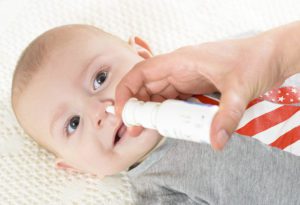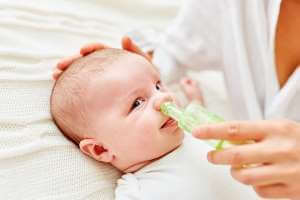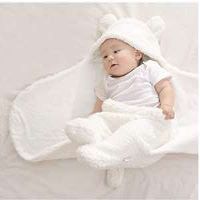Saline nasal drops for children are the perfect home remedy for nasal congestion and colds in children. When it comes to viruses like the common cold, there is nothing you can do to treat the cold itself. However, you can treat the symptoms that accompany a cold and congestion.

If you have a child with a cold, and you're looking for something to offer a little relief, you have options, including using saline nose drops.
Do you need: Baby nails, how to cut them, the correct ways to do so without hurting him
What are saline nose drops?
It is a saline solution made of salt water used to moisturize the nasal passages and provide relief from swelling and nasal congestion. It is available for purchase without a prescription, or you can make a saline solution at home.
Nasal congestion is a common side effect of a cold. Babies breathe only through their noses, not their mouths. Nasal congestion, therefore, impairs their breathing, especially during feeding.
Do you need: Bathing the baby, the guide and basic rules for caring for the newborn baby
Why is it used for children?
Over-the-counter treatments for adults are designed to reduce swelling and allow for easier breathing. While not an option for young children, using saline nasal drops can help reduce nasal congestion and mucus buildup.

The salt in the saline solution helps reduce inflammation in the mucous membranes. This solution also helps relieve any blockage while restoring moisture to the sinuses.
These drops are recommended for frequent use by infants and young children because they do not contain any medication. They are safe for use on your little one and can provide the relief they need.
Do you need: Child escaping from bed, how to teach a child to sleep in his bed
Will it help my child recover from a cold?
Common causes of congestion that require antibiotics include ear infections and sinus infections. If your child has an infection and may need antibiotics, here are some signs to look for.
Saline nose drops for children, how to use them, ways to make them at home
Ear pull: Ear discomfort is a classic sign of an ear infection. Children may cry and pull at their ears. You may notice redness or drainage, but often there are no outward signs of an ear infection. If you suspect an ear infection, take your child to a pediatrician, who will examine the ear canal and eardrum.
Fever: A fever higher than 103°F (39.5°C), especially a fever that doesn't respond well to medication or comes back repeatedly, may be a sign of a more serious infection.
Thick nasal discharge, especially if it is colored: While heavy discharge may occur during a cold, it should be clear and odorless. If you experience thick, green mucus, it's time to see your doctor.
Wet cough: If your child is coughing up mucus, especially if it is not clear in color, it is worth seeing a doctor.
bad smell: An infection is often accompanied by an odor. If there is a foul odor, whether coming from the ears, mouth, or nose, there is likely an infection. Allergies can cause similar problems. If your child has congestion that lasts for more than 10 days, see your doctor to discuss alternative causes. Your child may need a different treatment plan.
Do you need: cloth diapers, how to wash them, good washing and sterilization methods
Making saline nose drops at home
Saline nose drops can be found at pharmacies and purchased without a prescription. Need drops suddenly in the middle of the night? No problem. No special trip is necessary—you can make your own saline nose drops with items you probably already have in your kitchen.

Regular kosher salt works best for making these drops. Avoid using brands of salt that contain additives.
- 2.5/XNUMX teaspoon (XNUMX grams) of salt.
- Eight ounces of distilled or sterile water.
- You should plan to use the saline solution at room temperature.
Do you need: Pedi Light “rehydration solution” to treat dehydration in children?
How to give saline nose drops to a child
Once you have the nasal saline solution, you'll need to prepare to administer it. Simply insert one or two drops of the solution into one nostril and allow it to drain into the nasal cavity. Repeat on the other side. This can seem like a daunting task, however, when you have an uncomfortable child.
To get the best results when using saline nose drops, take the following steps:
- Using a dropper, lie your baby on your lap, with their head slightly toward the floor – use gravity to help the saline get where it needs to go.
- Place one or two drops in each nostril. Allow your child to remain tilted for a few minutes, if possible. This may encourage sneezing, which helps loosen and clear mucus buildup in the nasal passages.
- Using the aspirator, gently remove any loose mucus.
- Squeeze all the air out of the aspirator before placing it inside your baby's nose.
- Use nasal drops before breastfeeding so that the baby can breathe through his nose while breastfeeding.
- Do not use nasal drops for more than 3 to 4 hours.
- Safety precautions to take when using saline nasal drops for children
- Follow some basic safety precautions:
- Ensure your hands and all equipment are clean. Always wash your hands thoroughly before and after application to reduce the spread of germs. The dropper or pump should also be sterilized after each use.
- If your child starts coughing, let him sit up.
- Weakness, lethargy, difficulty breathing, and irregular heartbeat are never normal and require immediate medical attention.
Do you need: Burping a baby after breastfeeding, tricks and tips to do it the right way
Tips for overcoming nasal congestion in children
In addition to using saline nasal drops for your child, here are some techniques you can use to help reduce congestion in children:
- Use a cool mist humidifier to moisten the air.
- Vaseline gently applied under the nose can help prevent cracking of the raw skin.
- The warm steam from a hot shower can help loosen trapped mucus.
- You can hold your baby with the door closed in your bathroom while the hot water runs in the shower.
- Keep your baby hydrated.
- It's true that you can't shorten the length of a cold, but you can make your child more comfortable. These techniques, along with the use of nasal drops, can make a big difference for your child.
Do you need: Infant crying during sleep, its causes, is it dangerous for the child?
Keeping your child comfortable during colds and congestion with saline nasal drops
Using saline drops can be a good way to provide your child with relief from congestion. When your child isn't feeling well, even small measures can add up to a significant increase in comfort.
How do you manage congestion in your little ones? Do you have a favorite remedy that we haven't discussed here? Have you used saline nasal drops successfully? We'd love to hear about it—leave us a comment below.
the source : How To Use Saline Nose Drops For Your Baby










